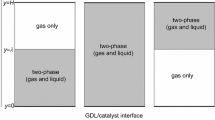Abstract
In small fuel cell applications, it is desirable to take care of the management of reactants, water and heat by passive means in order to minimize parasitic losses. A polymer electrolyte membrane fuel cell, in which air flow on the cathode was driven by free convection, was studied by experimental and modelling methods. The cathode side of the cell had straight vertical channels with their ends open to the ambient air. A two-dimensional, isothermal and steady state model was developed for the cathode side to identify the limiting processes of mass transport. The modelled domain consists of the cathode gas channel and the gas diffusion layer. Experimental data from current distribution measurements were used to provide boundary conditions for oxygen consumption and water production. The model results indicate that at the cell temperature of 40 °C the performance of the cell was limited by water removal. At the cell temperature of 60 °C, the current distribution was determined by the partial pressure of oxygen.
Similar content being viewed by others
References
A. Heinzel, C. Hebling, M. Müller, M. Zedda and C. Müller, J. Power Sources 105 (2002) 250.
J.P. Meyers and H.L. Maynard, J. Power Sources 109 (2002) 76.
C.K. Dyer, J. Power Sources 106 (2002) 31.
J. Vanhanen, ‘On the performance improvements of small-scale photovoltaic-hydrogen systems’, Dissertation (Helsinki University of Technology, Espoo, 1996).
T.B. Atwater, P.J. Cygan and C.L. Fee, J. Power Sources 91 (2000) 27.
J.M. Moore, B.J. Lakeman and G.O. Mepsted, J. Power Sources 106 (2002) 16.
J.W. Raadschelders and T. Jansen, J. Power Sources 96 (2001) 160.
D. Chu, R. Jiang, K. Gardner, R. Jacobs, J. Schmidt, T. Quakenbush and J. Stephens, J. Power Sources 96 (2001) 174.
D.M. Bernardi and M. Verbrugge, AIChE J. 37 (1991) 1151.
D.M. Bernardi and M. Verbrugge, J. Electrochem. Soc. 139 (1992) 2477.
T.E. Springer, T.A. Zawodzinski and S. Gottesfeld, J. Electrochem. Soc. 138 (1991) 2334.
T.E. Springer, M.S. Wilson and S. Gottesfeld, J. Electrochem. Soc. 140 (1993) 3513.
T.F. Fuller and J. Newman, J. Electrohem. Soc. 140 (1993) 1218.
T.V. Nguyen and R.E. White, J. Electrochem. Soc. 140 (1993) 2178.
V. Gurau, H. Liu and S. Kakac¸, AIChE J. 44 (1998) 2410.
S. Um, C-Y. Wang and K-S. Chen, J. Electrochem. Soc. 147 (2000) 4485.
K. Dannenberg, P. Ekdunge and G. Lindbergh, J. Appl. Electrochem. 30 (2000) 1377.
Z-H. Wang, C-Y. Wang and K-S. Chen, J. Power Sources 94 (2001) 40.
D. Natarajan and T.V. Nguyen, J. Electrochem. Soc. 148 (2001) A1324.
W. He, J.S. Yi and T.V. Nguyen, AIChE J. 46 (2000) 2053.
G.J.M. Janssen, J. Electrochem. Soc. 148 (2001) A1313.
T. Berning, D.M. Lu and N. Djilali, J. Power Sources 106 (2002) 284.
A. Rowe and X. Li, J. Power Sources 102 (2001) 82.
M. Wöhr, K. Bollwin, W. Schnurnberger, M. Fisher, W. Neubrand and G. Eigenberger, Int. J. Hydrogen Energy 23 (1998) 213.
S. Shimpalee and S. Dutta, J. Numer. Heat Transf. Part A 38 (2000) 111.
S. Shimpalee, ‘Numerical prediction of gas-humidification effects on energy transfer in PEM fuel cells’, Dissertation (University of South Carolina, Columbia, 2001).
M. Noponen, T. Mennola, M. Mikkola, T. Hottinen and P. Lund, J. Power Sources 106 (2002) 304.
M. Noponen, T. Hottinen, T. Mennola, M. Mikkola and P. Lund, J. Appl. Electrochem., submitted and accepted.
M. Roos, U. Harnisch and T. Hocker, ‘Incompressible Flow Through Ducts’, Internal report (Center for Computational Physics, Zürich University of Applied Sciences Winterthur, Switzerland, 2002).
K-T. Lee, Int. J. Heat Mass Transf. 42 (1999) 4523.
E.N. Fuller, P.D. Schettler and J.C. Giddings, Ind. Eng. Chem. 58 (1966) 19.
R.B. Bird, W.E. Stewart and E.N. Lightfoot, ’Transport phenomena’. (J. Wiley & Sons, New York, 1960).
J. Neutzler, J.W. Bostaph and A.M. Fisher, Patent WO 0 249 136 (2002).
M.S. Wilson, US Patent 5 514 486 (1996).
J.K. Neutzler and M.S. Wilson, US Patent 5 595 834 (1997).
R. Jiang and D. Chu, J. Power Sources 93 (2001) 25.
H. Chang, J-R. Kim, J-H. Cho, H-K. Kim and K-H. Choi, Solid State Ionics 148 (2002) 601.
Author information
Authors and Affiliations
Corresponding author
Rights and permissions
About this article
Cite this article
Mennola, T., Noponen, M., Aronniemi, M. et al. Mass transport in the cathode of a free-breathing polymer electrolyte membrane fuel cell. Journal of Applied Electrochemistry 33, 979–987 (2003). https://doi.org/10.1023/A:1026279431097
Issue Date:
DOI: https://doi.org/10.1023/A:1026279431097




